Do you have a question about the Buderus Logano GB125 BE and is the answer not in the manual?
Essential safety guidelines and precautions for operating the boiler and its system.
Defines warning symbols, signal words, and notes used throughout the manual for clarity.
Details the primary applications and purpose of the boiler for central heating and domestic hot water.
Outlines the installer's responsibility to adhere to all applicable federal, state, and local codes.
Provides key considerations for installation, operation, and compliance with local building codes and regulations.
Describes the boiler's main components including control panel, casing, boiler block, burner, and heat exchanger system.
Highlights the importance of water quality to prevent damage from scale formation and corrosion.
Lists standard and recommended tools, materials, and accessories needed for installation and maintenance.
Details the components included in the boiler's delivery package and instructions for checking.
Presents detailed technical specifications and dimensional data for the boiler models.
Specifies operating conditions for reliability and service life, including boiler room, fuel, power, and hydraulic requirements.
Provides instructions for environmentally responsible disposal of packaging and replaced system components.
Describes how to reduce boiler weight by removing the burner hood and door for easier handling.
Explains safe methods for lifting and carrying the boiler, including grip positions and warnings.
Details the procedure for safely moving the boiler using a hand truck, emphasizing secure loading.
Specifies the recommended and minimum wall clearances required around the boiler for safe installation and access.
Provides instructions on how to change the burner door hinges from right-hand to left-hand opening.
Guides on installing and adjusting the feet to level the boiler, preventing air pockets.
Details the final positioning and leveling of the boiler using adjustable feet and a level.
Covers flue pipe installation types and regulations for safe combustion air supply and flue gas routing.
Explains the purpose and use of dedicated testing ports for flue gas and combustion air temperature readings.
Presents approved flue gas systems and installation types available from Buderus for the boiler.
Details the process of connecting the boiler's water supply and return lines, including safety precautions.
Guides on filling the heating system, checking for leaks, and pressure testing, with safety warnings.
Details the installation of the oil filter (Tigerloop) and connection of the fuel supply line according to local codes.
Explains the installation and filling of the siphon and neutralizer for condensate drainage.
Covers electrical connections, including installing the control panel and temperature sensor assembly.
Describes the procedure for installing the control panel cover and the rear boiler top panel.
Details how to fill the system, bleed air, and achieve the correct operating pressure before commissioning.
Explains the procedure for testing the safety valve to ensure it functions correctly and releases excess pressure.
Instructs on checking and adjusting the heat exchanger baffles to ensure they are in the correct horizontal position.
Outlines the final steps to prepare the system for operation, including opening fuel supply and switching on power.
Guides on turning on the control panel, resetting limits, and starting the burner according to instructions.
Provides guidance on performing combustion tests and taking measurements after initial burner operation.
Explains how to check the function of the manual reset high limit (STB) for safety.
Details the process of positioning and securing the burner hood onto the boiler casing.
Provides a checklist for commissioning steps, including readings, dates, and confirmation.
Describes the standard procedure for safely shutting down the boiler and heating system using the control panel.
Explains the emergency shutdown procedure, including using the emergency shut-off switch or circuit breaker.
Explains the benefits of regular maintenance for efficiency, reliability, combustion, and service life.
Outlines the necessary safety precautions and steps to prepare the boiler before commencing inspection.
Details methods for cleaning the boiler using brushes or a wet method, including safety precautions.
Guides on opening and cleaning the heat exchanger system, including removing baffles and access covers.
Provides instructions for cleaning the condensate siphon and neutralizing system, with safety warnings.
Describes how to inspect and clean the corrugated hose for combustion air supply.
Details how to check the system pressure, add water if low, and ensure proper bleeding and expansion vessel function.
Explains the procedure for checking the safety valve's function at regular intervals.
Focuses on checking the combustion air supply and flue gas routing for issues like dirt, leaks, and blockages.
Advises checking the air supply system for blockages if CO2/CO levels are too high.
Provides forms for recording inspection and maintenance activities, including dates and signatures.
Guides on how to correct burner faults, including resetting the burner and notifying a technician.
Defines abbreviations used in the installation examples and diagrams for clarity.
Lists part numbers for components of the boiler block and burner door, categorized by model.
Provides a list of part numbers for components related to the boiler's outer casing.
Details the spare parts available for the heat exchanger (WT) system, including part numbers.
Essential safety guidelines and precautions for operating the boiler and its system.
Defines warning symbols, signal words, and notes used throughout the manual for clarity.
Details the primary applications and purpose of the boiler for central heating and domestic hot water.
Outlines the installer's responsibility to adhere to all applicable federal, state, and local codes.
Provides key considerations for installation, operation, and compliance with local building codes and regulations.
Describes the boiler's main components including control panel, casing, boiler block, burner, and heat exchanger system.
Highlights the importance of water quality to prevent damage from scale formation and corrosion.
Lists standard and recommended tools, materials, and accessories needed for installation and maintenance.
Details the components included in the boiler's delivery package and instructions for checking.
Presents detailed technical specifications and dimensional data for the boiler models.
Specifies operating conditions for reliability and service life, including boiler room, fuel, power, and hydraulic requirements.
Provides instructions for environmentally responsible disposal of packaging and replaced system components.
Describes how to reduce boiler weight by removing the burner hood and door for easier handling.
Explains safe methods for lifting and carrying the boiler, including grip positions and warnings.
Details the procedure for safely moving the boiler using a hand truck, emphasizing secure loading.
Specifies the recommended and minimum wall clearances required around the boiler for safe installation and access.
Provides instructions on how to change the burner door hinges from right-hand to left-hand opening.
Guides on installing and adjusting the feet to level the boiler, preventing air pockets.
Details the final positioning and leveling of the boiler using adjustable feet and a level.
Covers flue pipe installation types and regulations for safe combustion air supply and flue gas routing.
Explains the purpose and use of dedicated testing ports for flue gas and combustion air temperature readings.
Presents approved flue gas systems and installation types available from Buderus for the boiler.
Details the process of connecting the boiler's water supply and return lines, including safety precautions.
Guides on filling the heating system, checking for leaks, and pressure testing, with safety warnings.
Details the installation of the oil filter (Tigerloop) and connection of the fuel supply line according to local codes.
Explains the installation and filling of the siphon and neutralizer for condensate drainage.
Covers electrical connections, including installing the control panel and temperature sensor assembly.
Describes the procedure for installing the control panel cover and the rear boiler top panel.
Details how to fill the system, bleed air, and achieve the correct operating pressure before commissioning.
Explains the procedure for testing the safety valve to ensure it functions correctly and releases excess pressure.
Instructs on checking and adjusting the heat exchanger baffles to ensure they are in the correct horizontal position.
Outlines the final steps to prepare the system for operation, including opening fuel supply and switching on power.
Guides on turning on the control panel, resetting limits, and starting the burner according to instructions.
Provides guidance on performing combustion tests and taking measurements after initial burner operation.
Explains how to check the function of the manual reset high limit (STB) for safety.
Details the process of positioning and securing the burner hood onto the boiler casing.
Provides a checklist for commissioning steps, including readings, dates, and confirmation.
Describes the standard procedure for safely shutting down the boiler and heating system using the control panel.
Explains the emergency shutdown procedure, including using the emergency shut-off switch or circuit breaker.
Explains the benefits of regular maintenance for efficiency, reliability, combustion, and service life.
Outlines the necessary safety precautions and steps to prepare the boiler before commencing inspection.
Details methods for cleaning the boiler using brushes or a wet method, including safety precautions.
Guides on opening and cleaning the heat exchanger system, including removing baffles and access covers.
Provides instructions for cleaning the condensate siphon and neutralizing system, with safety warnings.
Describes how to inspect and clean the corrugated hose for combustion air supply.
Details how to check the system pressure, add water if low, and ensure proper bleeding and expansion vessel function.
Explains the procedure for checking the safety valve's function at regular intervals.
Focuses on checking the combustion air supply and flue gas routing for issues like dirt, leaks, and blockages.
Advises checking the air supply system for blockages if CO2/CO levels are too high.
Provides forms for recording inspection and maintenance activities, including dates and signatures.
Guides on how to correct burner faults, including resetting the burner and notifying a technician.
Defines abbreviations used in the installation examples and diagrams for clarity.
Lists part numbers for components of the boiler block and burner door, categorized by model.
Provides a list of part numbers for components related to the boiler's outer casing.
Details the spare parts available for the heat exchanger (WT) system, including part numbers.
| Installation Type | Wall-mounted |
|---|---|
| Combustion System | Premix Burner |
| Boiler Type | Condensing |
| Water Content | Approx. 3.5 liters |
| Max. Operating Pressure | 3 bar |
| Type | Condensing boiler |
| Fuel Type | Natural gas |
| Efficiency | Up to 98% |
| Standard Efficiency | Up to 98% |
| Modulation Range | 1:5 |
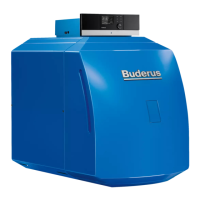
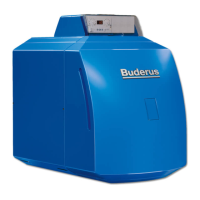
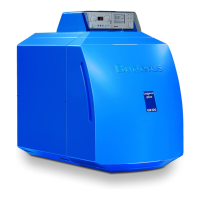
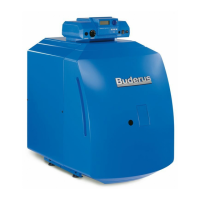
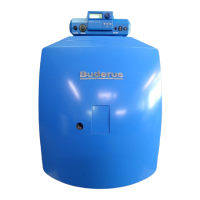
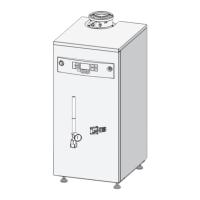
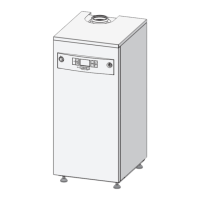


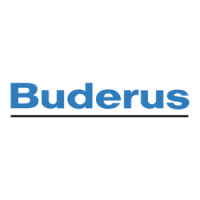
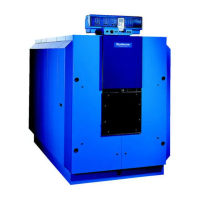

